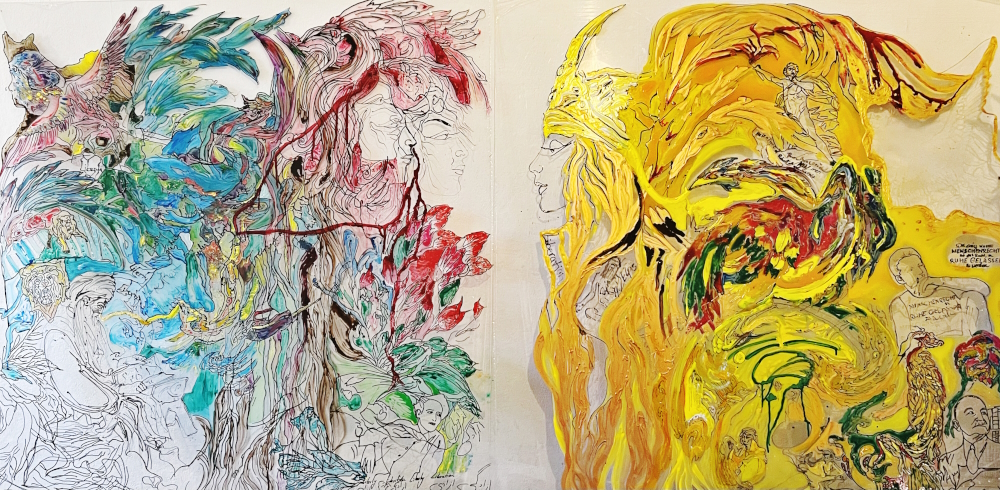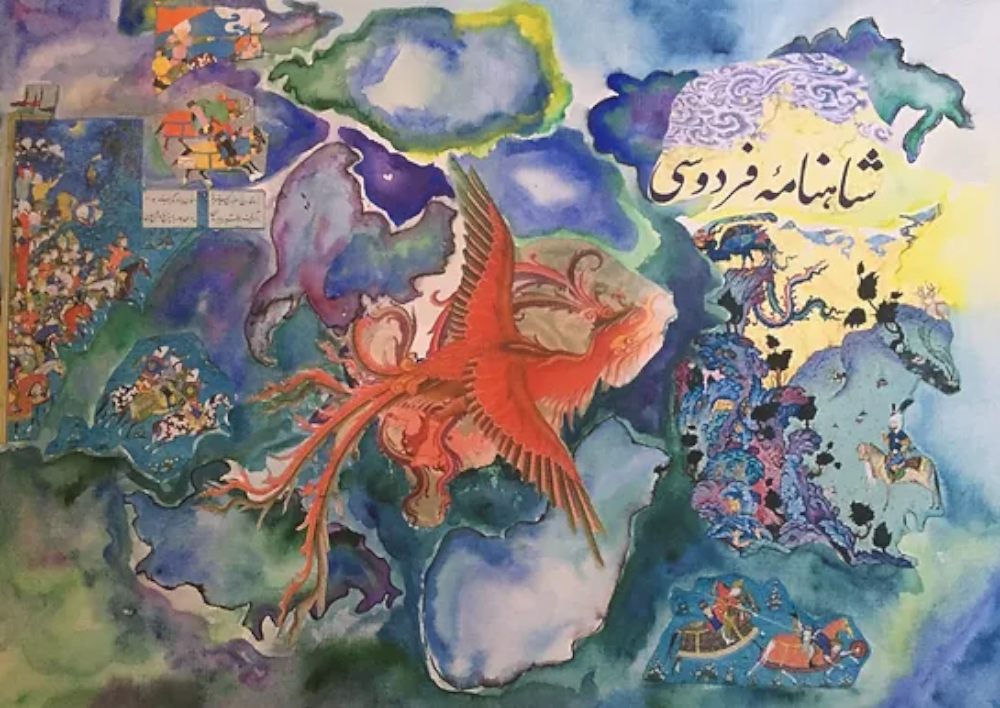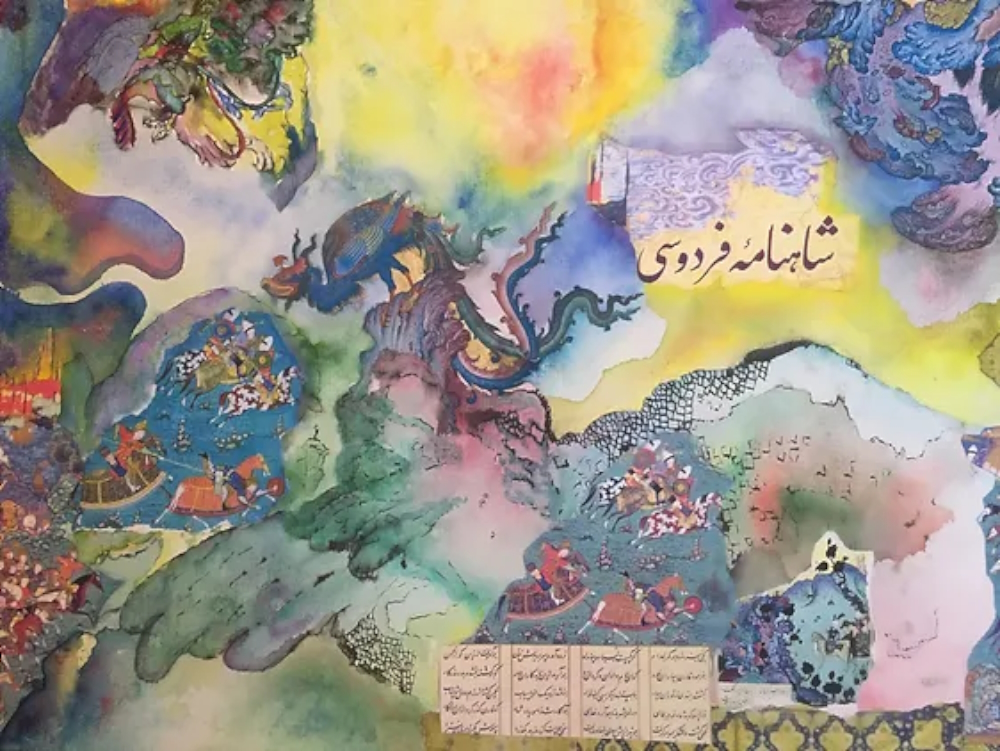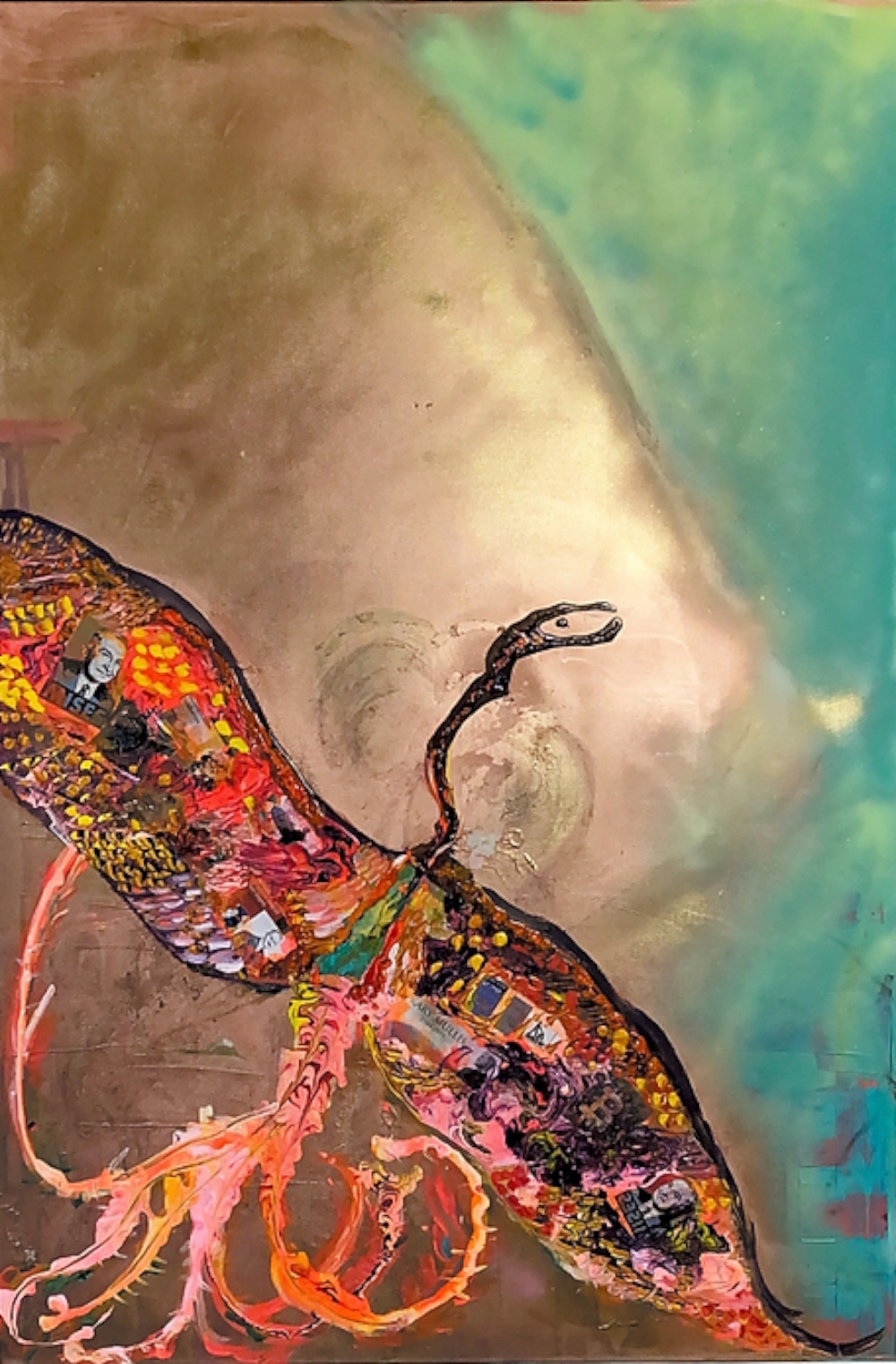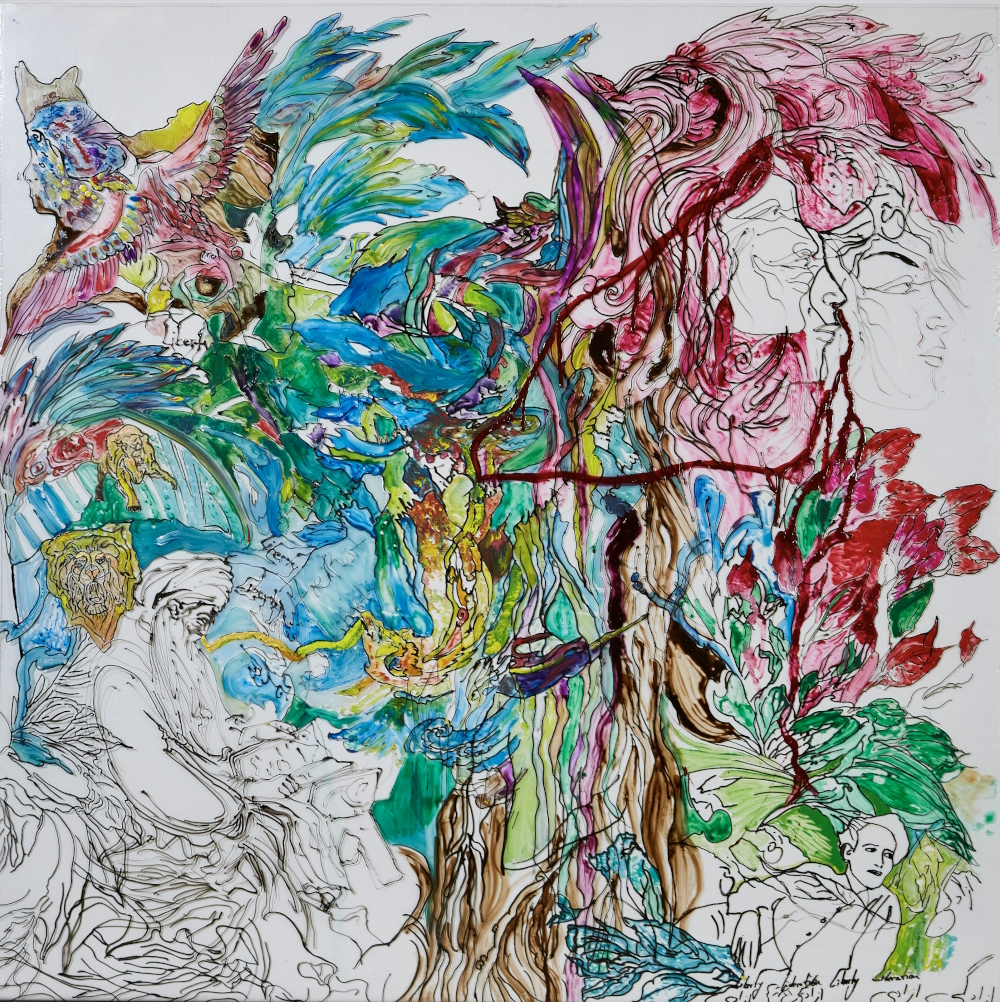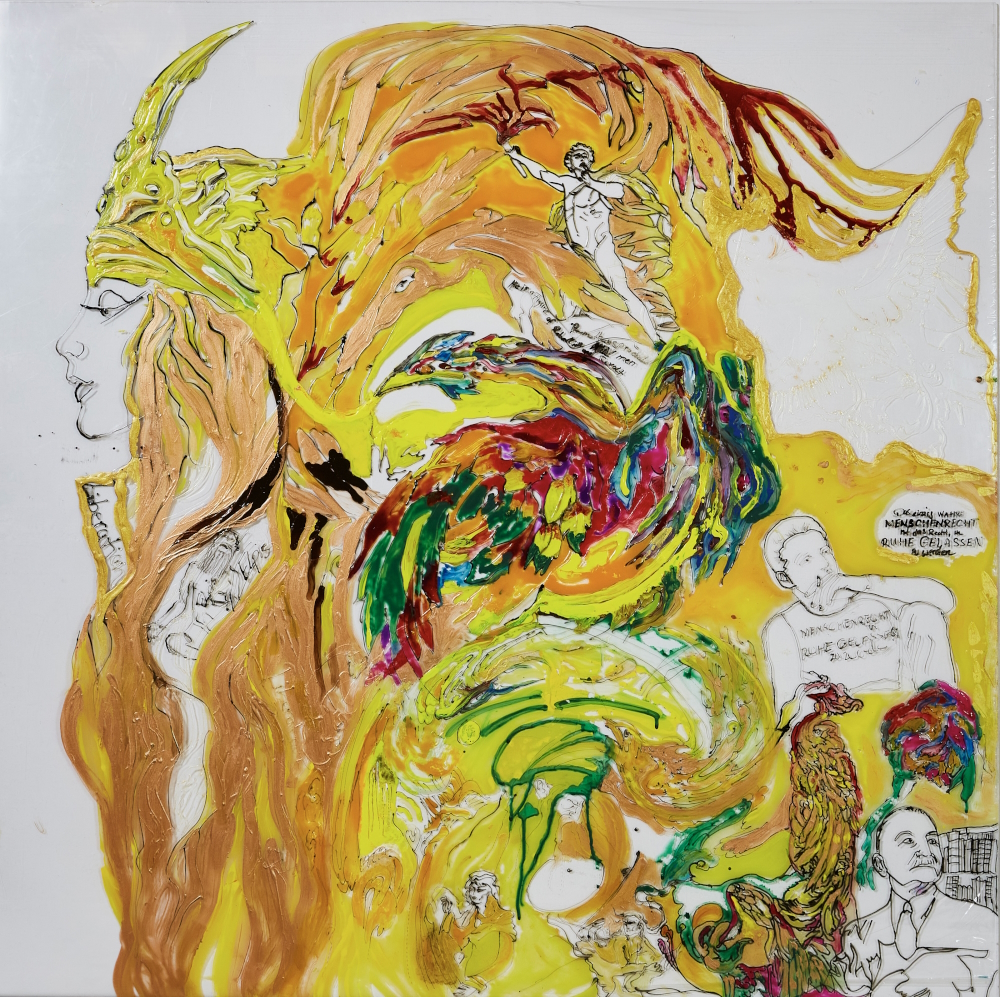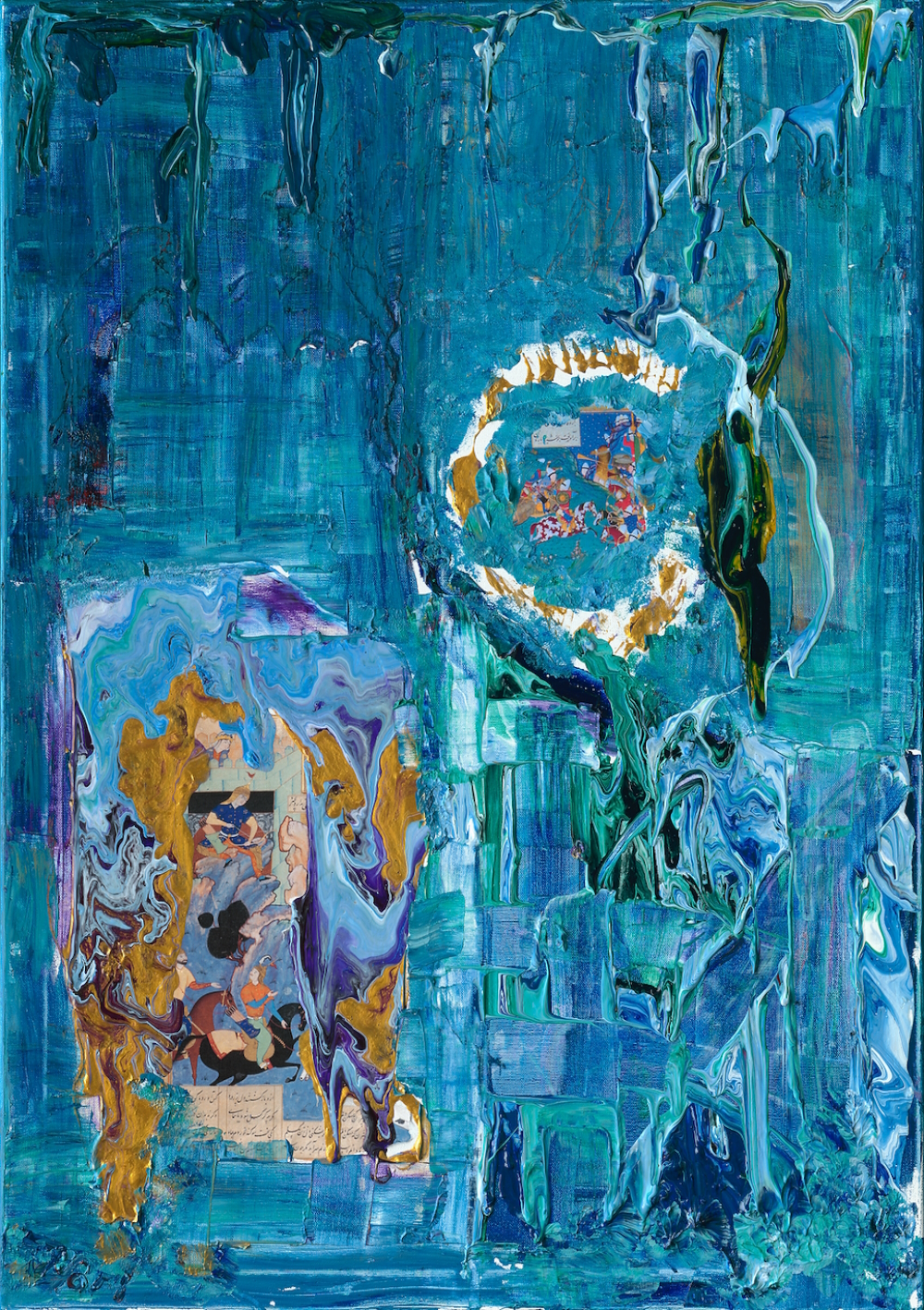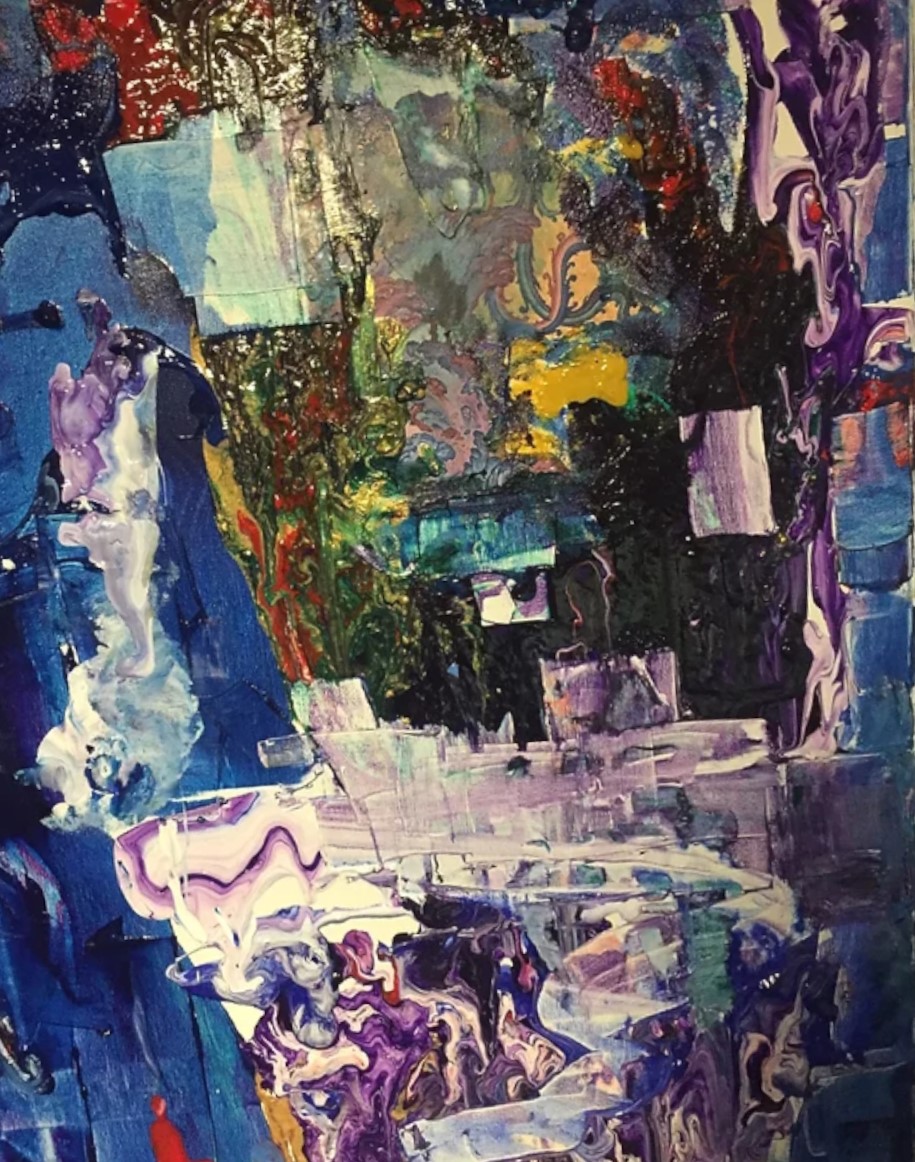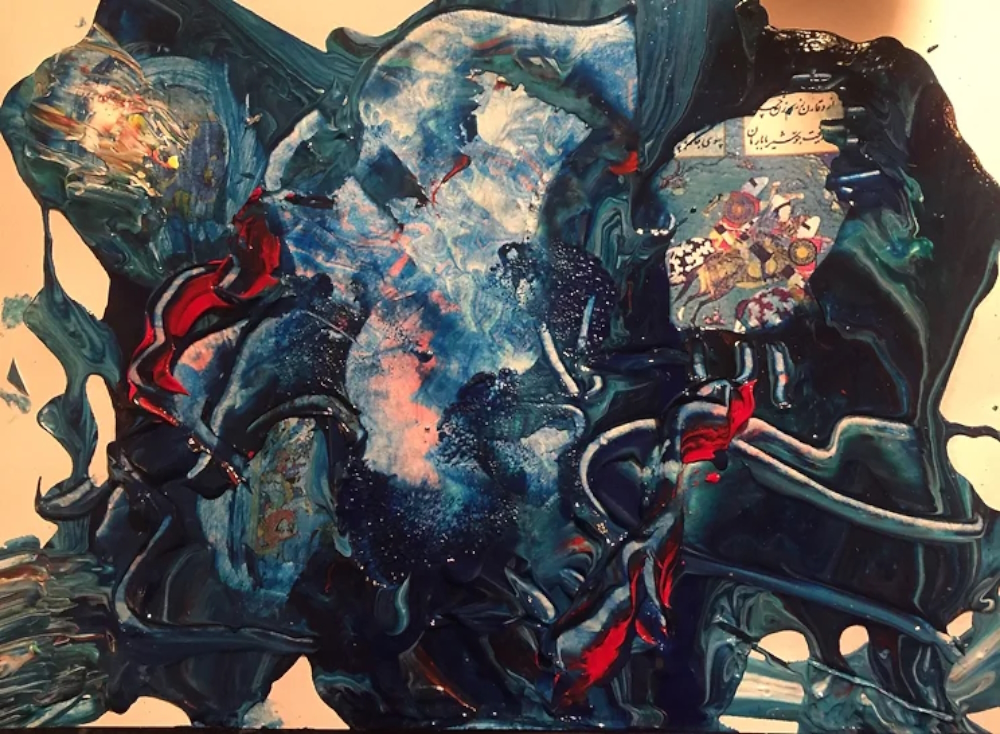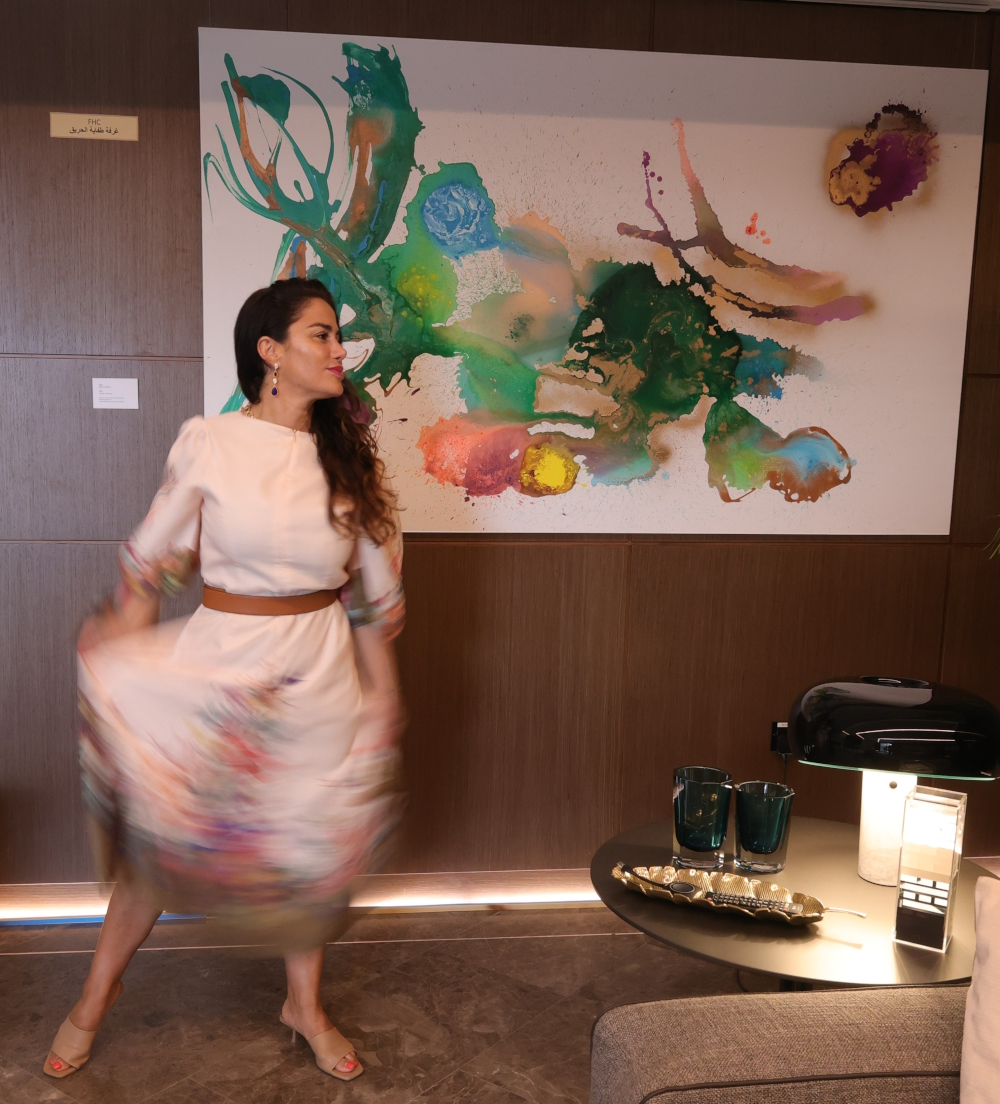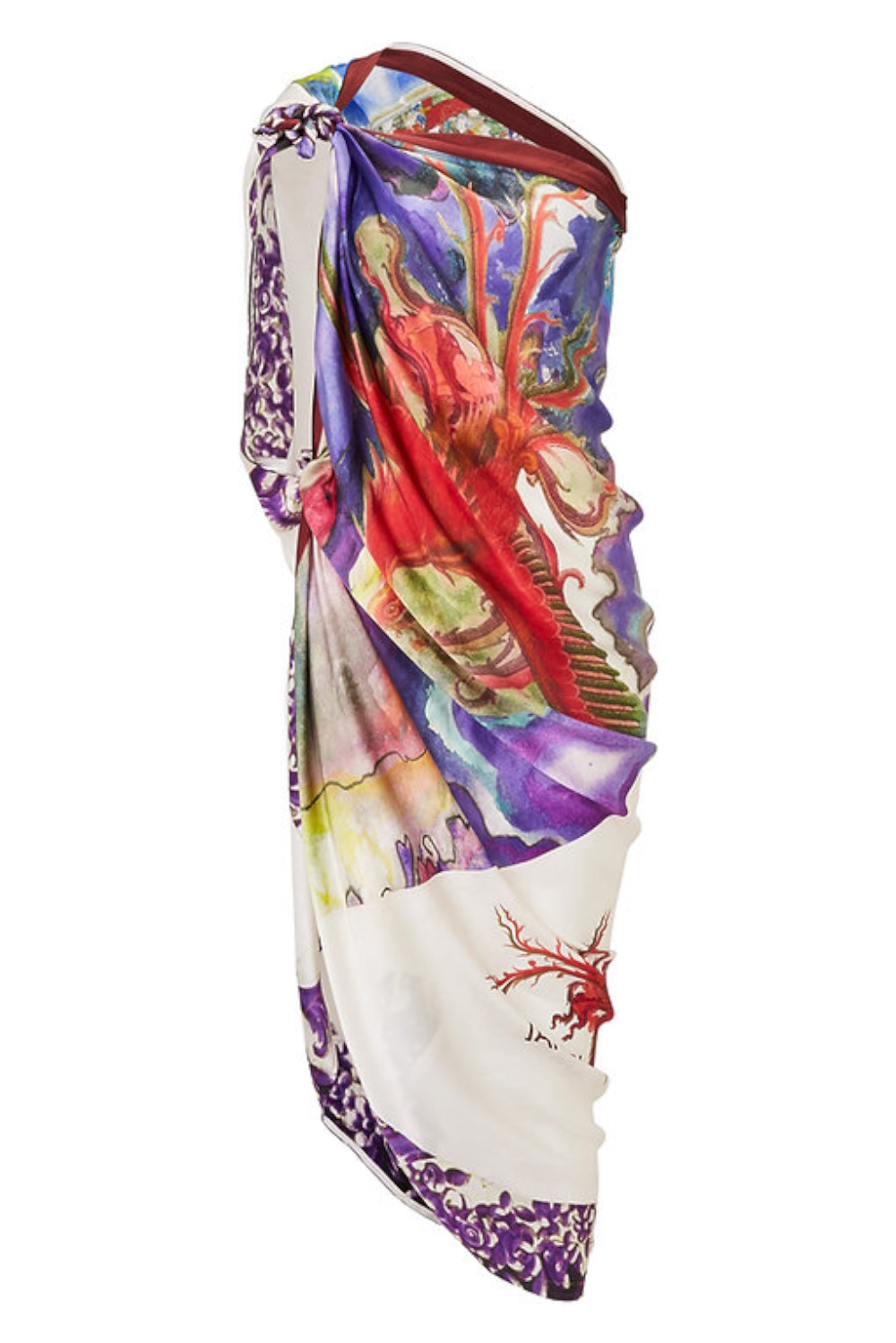Elnaz Jàfari
Persian painter & fashion designer
Iran / Germany
The mansions of The Ritz-Carlton Residence in Dubai, the 25hours Hotel there and the London Art Biennale 2023 have one thing in common: artworks by an native Iranian creative who the media describes as “a walker between worlds“ are present at these far apart places. Her colorful, symbolic East meets West output is labelled as „wearable art“ featuring paintings and fashion – both being connected by a link: showing signs of hope and the beauty of freedom.
Elnaz Jàfari
Persian painter & fashion designer
Iran / Germany
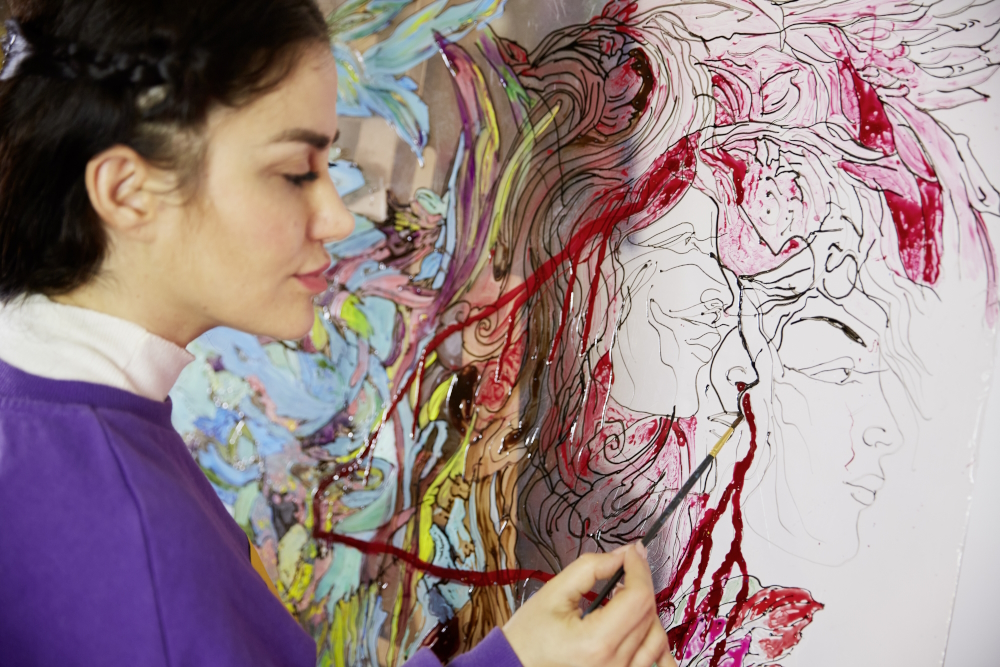
Thanks to the dragon Simorgh, this woman has realised her secret occupation aspiration when she was an adult standing on career crossroads! „The mythical bird from Persia's oldest ‚Book of Kings‘ (‚Schāhnāme‘) made me fly everywhere on its wings from an early age“, Elnaz Jàfari (* 1983 in Tehran) told Art Dubai Magazine. When she was four years old her Persian parents immigrated with the kid and her sister to Hamburg (Germany). „We had to assert ourselves early on as the Persian twins who wanted to fit in and yet were always different and also looked different from the other children“, she wrote on her old website. „Early on, I started asking questions about how identities are formed and how the cultural milieu can shape and change people. At the age of seven I ‚studied‘ everything I could get my hands on about the ancient Egyptians, Greeks and Persians and was most impressed by Persian mythology and its symbols and what my family had told me about them. The question of identity and belonging and the contradictions I faced are today the fundamental themes of my art and life.“
This lady knows what she’s talking about because her remarks are based on personal experiences: „I looked Persian but felt German. I lived in Germany but still felt homeless. Early on I started to travel a lot and to look for my home. When I thought I had found it in Lisbon, I lost that too and was officially a nomad, devoting myself to my art. Unlike the oppositions I was exposed to for a long time - the Simorgh unified the limbo of unbelonging, into a cultural understanding of identity that explores how a person is defined by the cultural systems to which they belong.“
According to the Iranian believe for women from the middle-class to become either a lawyer or a dentist, Elnaz Jàfari conformed to the conventional wishes of her upbringing, enrolled for legal education at universities in Bordeaux as well as Paris and then successfully passed the state examination in Hamburg. But because she already had started painting as a child, this old love of hers broke its way and the dragon Simorgh came into play again. „I fantasized about flying into other worlds on his wings.“ That’s what she did in reality allegorical. The young lady studied in Florence und Milan (Italy) to do her MBA in Art, Design and Management, followed by working in the creative fashion industry while living in Lisboa (Portugal). But in this job it was impossible to live out her dreams, visions and artistic aspirations. So the multi-lingual globetrotter moved on again and decided to become an entrepreneur by setting up her own business.
Elnaz Jàfari’s entire oeuvre that reflects the two opposite elements of freedom and security, orient and oxides, identity and dualism, chaos and order, fear and hope, rise and fall, is generally full of colours and symbols. When asked about her artistic influences, she refers to her mother‘s Persian miniature painting style that is in love with detail and Max Ernst (1891-1976). The German painter and graphical artist (co-founder of Surrealism) invented the dripping method – something that she makes use of too. Regarding her creative process ‚EJ‘ has told German online-site ganz-hamburg.de something interesting: "The sadder or more emotional my mind, the more colourful my canvas!"
What refers to her fashion output which exists of elegant tonchas (large, versatile silk cloths to be used as (head)scarves, tops or dresses/ponchos, available on her website), the Iranian-German considers herself a soul mate with Elsa Schiaparelli (1890-1973). The Italian fashion designer and couturier transformed her artistic visions into wearable art also.
„In my artistic creative process“, Elnaz Jàfari reveals on her website, „I face the theme of identity not only in terms of content, but also in the creative process by giving the natural law of gravitation with colors their course and this way of colors my frame with form and symbolic power. In this process, the Simorgh accompanies and inspires me in my designs and is a central figure in my creative work. Over the years, it has undergone its transformation from a representational representation to the symbol of the abstract Simorgh. In doing so, I not only create paintings on canvas, but use sculpture, rugs, light installations and silks to create a broader representation of my sense of freedom and the matriarchy I grew up in through symbols and imagery.“
„With her paintings“, is to be read in a short feature-announcement of German regional programme ndr.de, „she wants to set a sign of hope regarding what is happening in Iran. ‚I am not a politician, but an artist. I can only use the instruments that are possible for me. Through the beauty of art I want to show what Iran really looks like when it's not like it is at the moment.‘ For doing so, the self proclaimed „free spirit“ gave a general advice in Art Dubai Magazine: „My message to everyone - especially women - is: Just do it! You are always strongest and happiest where you burn the most.“
Elnaz Jàfari is based in Hamburg (Germany).
Interview September 2023
Self-tangling thanks to a mystical dragon: signs of hope through the beauty of wearable art where Orient and Occident meet
INTUITION/IMAGINATION
?: How does intuition present itself to you – in form of a suspicious impression, a spontaneous visualisation or whatever - maybe in dreams?
Ideas may emerge as epiphanies, be born during my travels, or even manifest within dreams.
?: Will any ideas be written down immediately and archived?
I enjoy likening my process of idea generation to nature, akin to an active volcano continuously spewing forth lava. Everything flows within the cycle of life, where observations and perceptions accumulate impressions deeply resonating with what holds significance in the current momentum.
?: How do you come up with good or extraordinary ideas?
Over time, impressions and ideas accumulate. Within the coherence of this cycle, the urgency for realization seems to intensify. The perceived, germinated idea grows and expands, comparable to a natural phenomenon, it must pass through the birth canal, in this case, the volcano's crater, undergoing filtration before erupting explosively to the surface.
?: Do you feel that new creative ideas come as a whole or do you get like a little seed of inspiration that evolves into something else and has to be realized by endless trials and errors in form of constant developments until the final result?
That varies, but usually, the small idea starts to sprout and is spun further until it aligns with my DNA.
?: What if there is a deadline, but no intuition? Does the first fuel the latter maybe?
Art, for me, is the embodiment of ideas and imaginings. I continually harbor ideas yearning for realization, akin to children eagerly awaiting their birth, as depicted in Madeleine Peyroux's cover of the Leonard Cohen song "Dance Me To The End Of Love".
INSPIRATION
?: What inspires you and how do you stimulate this special form of imaginativeness?
My sources of inspiration are the three major themes of my life: freedom, matriarchy, and identity. In this context, identity reflects the past, matriarchy represents the present, and freedom symbolizes the future.
?: How do you filter between ideas that are worthwhile pursuing and bad ones that you just let go of?
The filtration of ideas unfolds seamlessly within the process of manifesting both concept and imagination. This transpires intuitively, wherein an idea aligns harmoniously with the framework of my identity, it materializes into reality.
?: Does an idea need to appeal to you primarily or is its commercial potential an essential factor?
Currently, I have the liberty to arrange my projects in a manner that personally resonates with me. In doing so, some ideas may receive a more favorable reception, while others perhaps less so, yet every idea deserving of realization remains accessible to the scrutiny of all.
?: Do you revisit old ideas or check what colleagues or competitors are up to at times?
All ideas, to a greater or lesser extent, fall within the three overarching categories of freedom, matriarchy, and identity, which means that an old idea can always resurface.
CREATIVITY
?: What time or environment best suits your creative work process — for example, a time and place of tranquility or of pressure? Which path do you take from theory or idea to creation?
I find that I work best during the nocturnal hours.
?: What’s better in the realization process — for example, speed and forcing creativity by grasping the magic of the moment or a slow, ripening process for implementation and elaboration?
I cannot exclude any process; some things unfold slowly, while others require spontaneous materialization in the moment.
Currently, I am traversing the Far East, and each day presents me with the opportunity to deepen ideas and intensify my research on various topics. Normally, I would assert that I excel in completing work under pressure. However, this journey reveals another facet of my creative self.
For example, many works for my exhibition in Hamburg in December 2023 are already confirmed, yet the flow of ideas for additional pieces within a series gains potency from the current distance, empowering a meticulous execution. Thus, I continuously acquire new insights within this process.
?: How important are self-doubt and criticism by others during such a process?
In the past, my self-doubt was so profound that I struggled to begin in earnest and never felt a sense of completion. I used to call this perfectionism. I once read that perfectionism is fear in high heels. That encapsulates it. Nowadays, I simply create, and if things don't turn out as I envision, I chalk it up as an experience and learn from it.
Sometimes, while engrossed in my work, I find myself questioning everything. In those moments, I'm grateful to have my partner or twin sister to turn to for guidance. Self-doubt can stop you in your tracks. I give it as little a voice as possible and instead concentrate on my more positive instincts - they will support me through. Criticism does not affect me if I truly have a vision and belief in what I am doing.
?: In case of a creative block or, worse, a real failure, how do you get out of such a hole?
The duration of projects' execution, in my perspective, does not equate to failure. Especially during the most challenging phases, I understand that after a low point, there will be a high. And I have learned to sometimes just enjoy the decline.
?: How are innovation and improvement possible if you’ve established a distinctive style?
I continually strive to remain in a state of growth and evolution, I hope that no work will ever need to resemble one from a previous era.
I consistently employ diverse artistic media to give form to my emotions and ideas. This leads to series where I utilize the technique of miniature painting, sometimes opting for drip painting, and occasionally blending both approaches on different materials. While drawing inspiration from my family's history, I acknowledge that art history has also demonstrated the close connection between art and the artist's identity.
?: When does the time come to end the creative process, to be content and set the final result free? Or is it always a work-in-progress, with an endless possibility of improvement?
You can see the two methods I work with as the battle between the mind and emotions, soul and matter. The work of the heart is juxtaposed with that of the brain. I categorize these two methods as impulsive and representational work. Impulsive works arise from the translation of raw emotions into reality, while representational works draw inspiration from historical, mythological, political, and contemporary contexts.
In meticulously planned creations like glasswork and antique carpet designs, every step is methodically considered. This is in contrast to intuitive painting, which follows the heart and gut, while representational painting is guided by intellectual frameworks.
In drip painting, my work is unpredictable, driven solely by my emotions. I provide a framework, and colors flow freely on the canvas, resulting in an interplay of hues shaped by chance, mirroring the forces of nature.”
Intuitive creations are executed spontaneously, often shrouding their appearance in mystery. They possess a natural authenticity reminiscent of the unique beauty found in nature.
In contrast, mind painting unfolds slowly and is often marked by perfectionist tendencies, meticulous planning, and a sense of never truly reaching completion.
?: Do you have a clue why your creations are exactly the way they are?
I guess that my creative path is shaped by my understanding of the Persian identity.
I love working colourful and with symbol-rich subjects that combine elements of the Persian world with Western and universal codes. Thereby all my works are subject to the big three pillars of my life: credo of freedom, identity and matriarchy. The recurring symbol of the mythical bird Simorgh stands as the singular, unwavering element in my creations. In Persian literature and art, the Simorgh is revered as the king of birds, symbolizing both freedom and supernatural might, while also assuming the role of a guardian presence.
SUCCESS
?: “Success is the ability to go from one failure to another with no loss of enthusiasm.“ Do you agree with Winston Churchill’s quote?
I do not know the word failure in art.
?: Should or can you resist the temptation to recycle a ‘formula’ you're successful with?
Each creation possesses a rightful place in the realm of existence, as it has navigated its journey from a humble idea or the limbo of non-existence into the tangible reality we perceive.
?: Is it desirable to create an ultimate or timeless work? Doesn’t “top of the ladder” bring up the question, “What’s next?” — that is, isn’t such a personal peak “the end”?
There are moments when ideas may not fully measure up to the standards of their materialization, yet even in those instances, the act of bringing an idea into material form remains, to me, the true essence of art.
MY FAVORITE WORK:
'Liberty versus liberation'.
What is liberty? What is liberation?
This work on glass features a Persian representational miniature painting that captures the contemporary zeitgeist surrounding the definition of freedom worldwide. It is a diptych that juxtaposes liberty and liberation, as defined by Hannah Arendt and Roland Baader.
In the right image of this diptych, liberation is depicted as a sublime woman, enlightened by the philanthropist Prometheus, in whose hair Elpis, the hope from Pandora's box, is concealed.
Prometheus was a deity who safeguarded humanity. He also symbolized rebellion and revolt. He taught us that challenging authority is honorable and sometimes necessary, but also cautioned against attempting to control the very essence of order. This was Prometheus's creed. Despite his remarkable foresight, this notion ultimately eluded him.
What is freedom? What is liberation?
Freedom emerges from oppression and carries responsibilities for individuals within the state, as Hannah Arendt delineated. Liberation, on the other hand, is the human right to exist unburdened, and sublime liberation answers to no one, drawing its strength from an innate trust in humanity — much like Prometheus. In the pursuit of liberty, one mustn't lose sight of their values and identity. Recognizing the true state of the world means understanding that it transcends left or right ideologies. We are interconnected, sharing a collective soul forever bound by empathy.
This truth is realized through the wisdom of Saadi, as we are all children of Adam, interconnected as parts of a whole, conceived as members of one body by the Lord God. "When one member suffers, the pain resonates throughout all. A person unmoved by the suffering of their fellow humans doesn't deserve to be called a human being" (Saadi, "Persian poet, one of the greatest figures in classical Persian literature"/Encyclopedia Britannica, 1213-1291).
